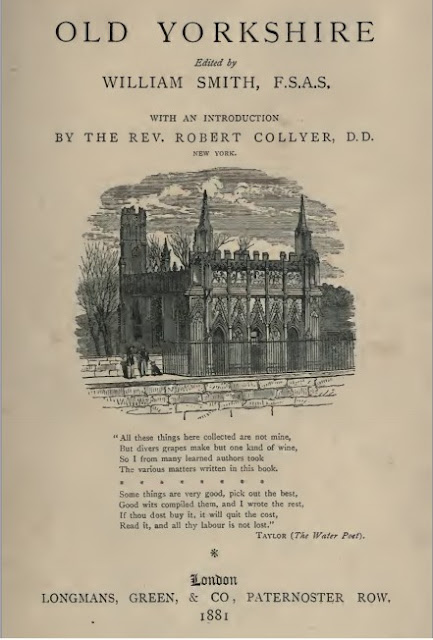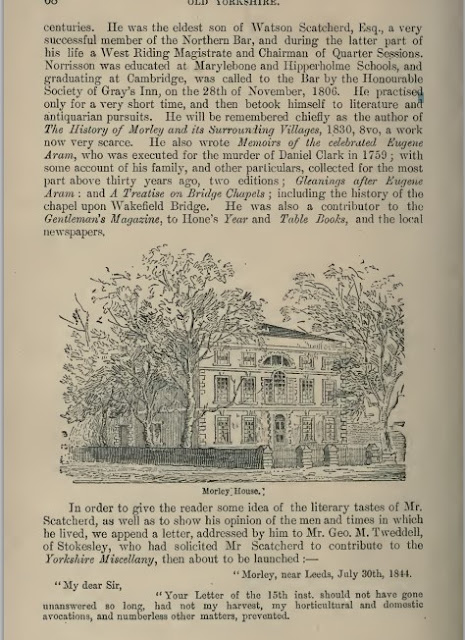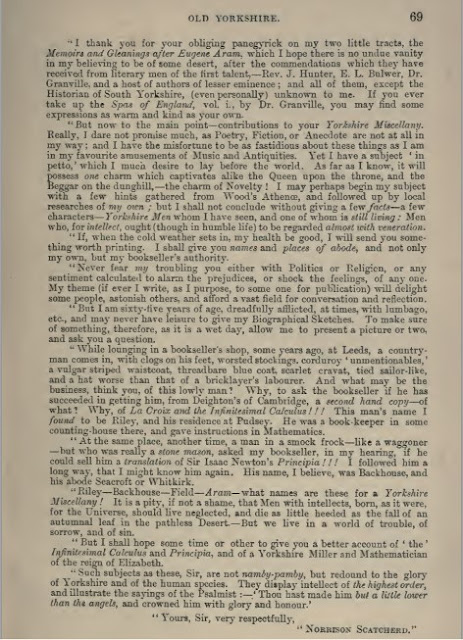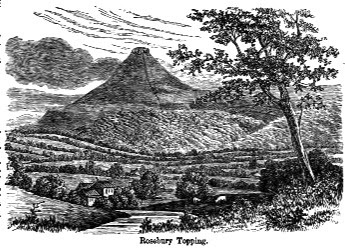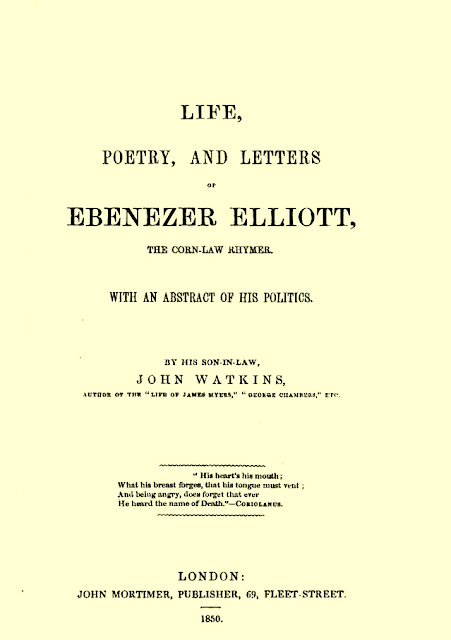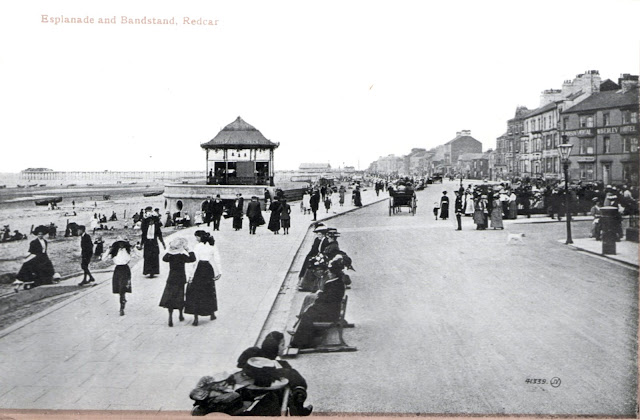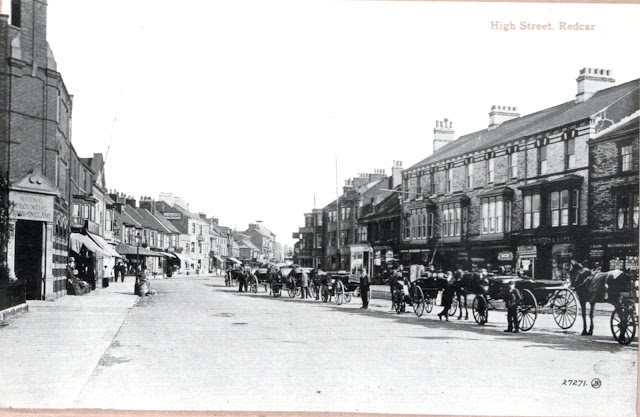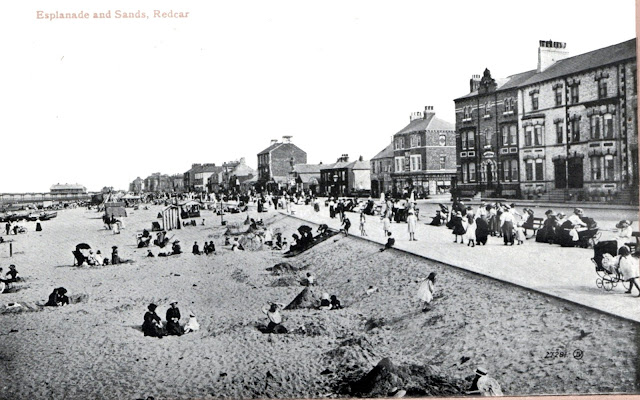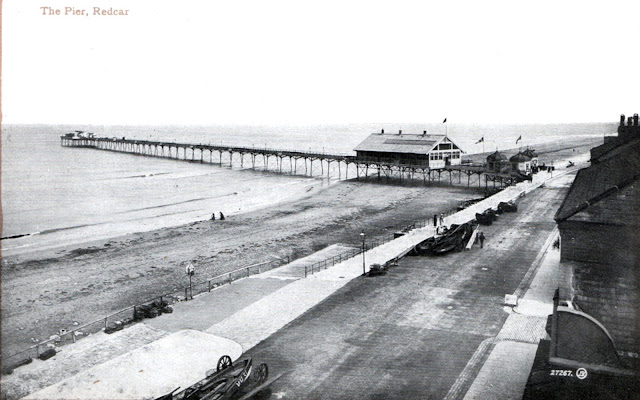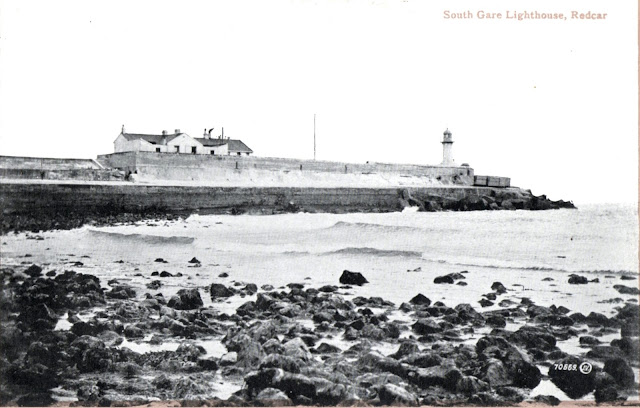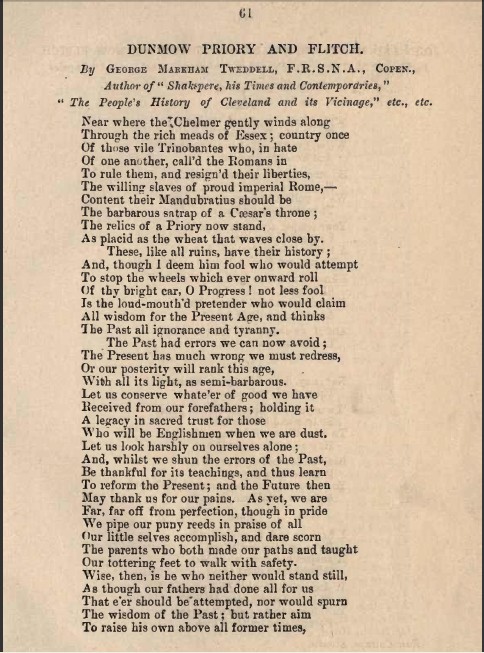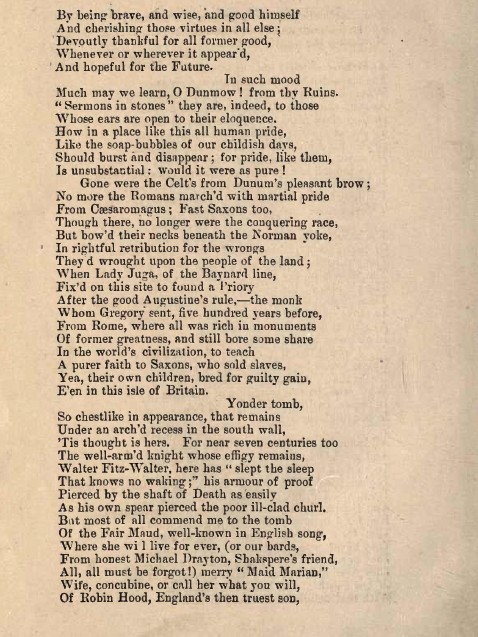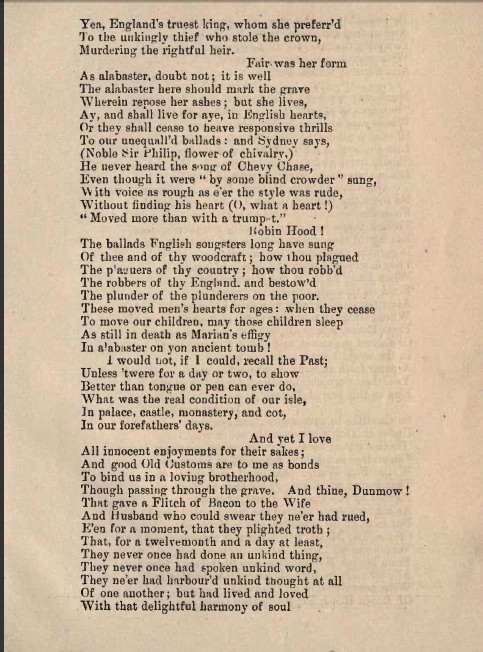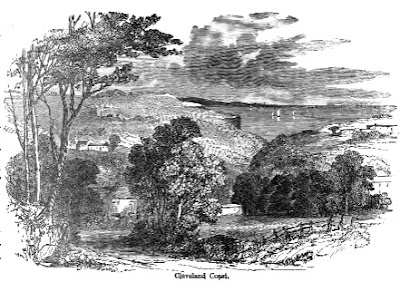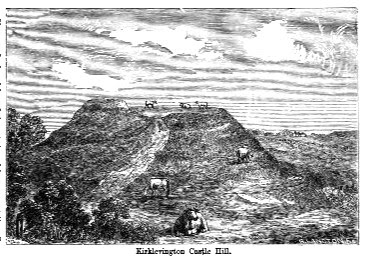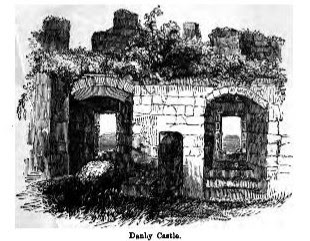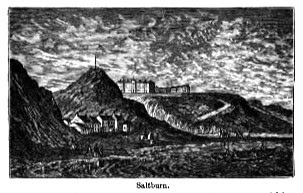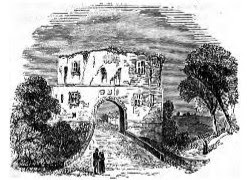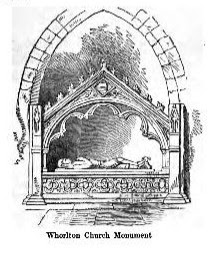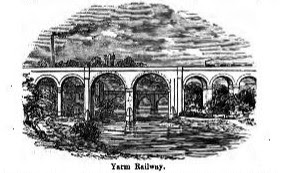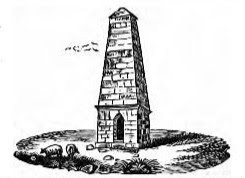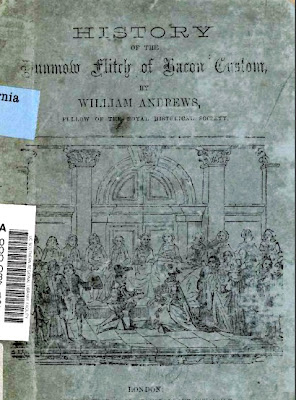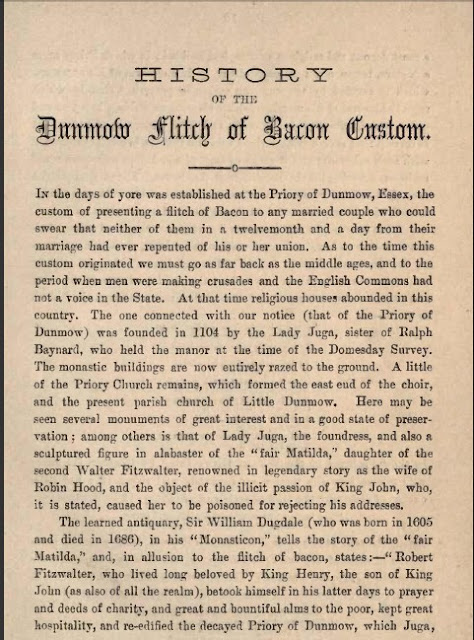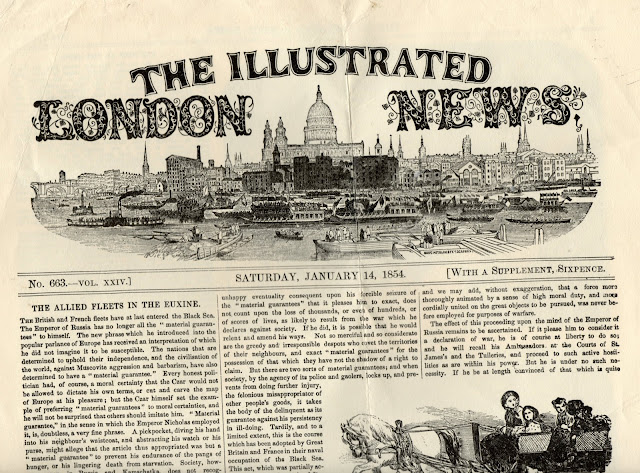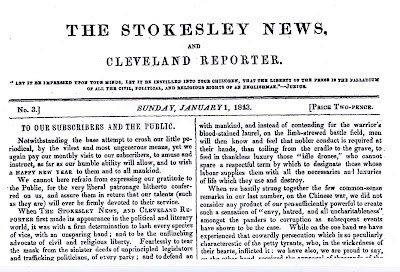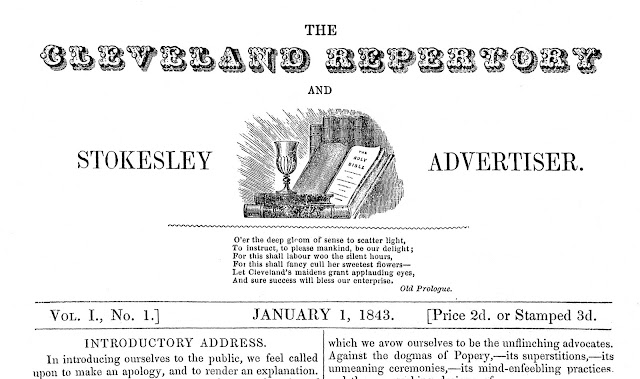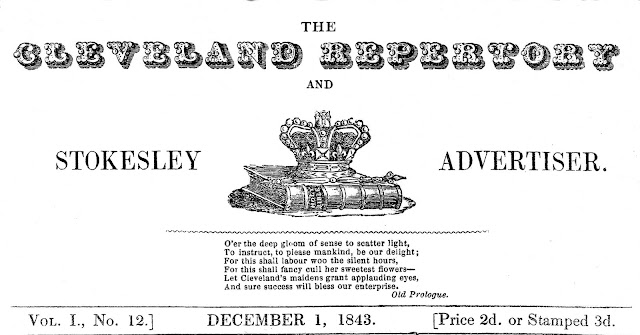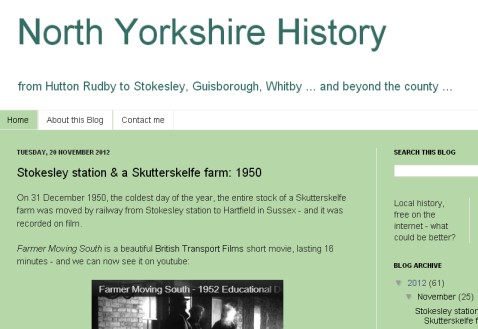 In c 1844 /5 when GM Tweddell was running Tweddell’sYorkshire Miscellany, he received a reply from a potential literary contributor Norrisson Cavendish Scatcherd FSA. This letter was published in the book Old Yorkshire Edited by William Smith F.S.A.S.in 1881
In c 1844 /5 when GM Tweddell was running Tweddell’sYorkshire Miscellany, he received a reply from a potential literary contributor Norrisson Cavendish Scatcherd FSA. This letter was published in the book Old Yorkshire Edited by William Smith F.S.A.S.in 1881
The whole book can be read on line or downloaded via here –
http://archive.org/details/oldyorkshire01smituoft
but the bit that is relative to George Markham Tweddell is below.
It relates to a possible contribution to Tweddell’s Yorkshire Miscellany based around a number of characters of intellect and culture but who emanate from poor backgrounds and some background on Norrisson Cavendish Scatcherd.
Ebenezer Elliott and George Markham Tweddell
Paul Tweddell wrote ( in a bio of George Markham Tweddell) and in response to Tony Nicholson’s research into ‘Cultural Encounters’ research –
Network of Interlinking Northern Radical Thinkers and Poets.
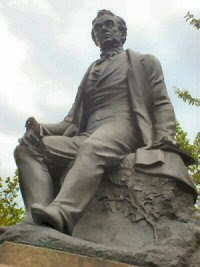 |
| Ebenezer Elliott |
” It is likely that research into Victorian intellectual activity in Yorkshire and the North East would find Tweddell’s life and work serving as a paradigm for its study. Tweddell’s work in North Yorkshire and South County Durham, for example, is part of a network of interlinking clusters of radical thinkers (or men sympathetic to their ideology) and interested in literature. Tweddell could be a candidate for Cleveland’s representative; William Andrews in Hull, Ebenezer Elliott in South Yorkshire, James Montgomery in West Yorkshire, John Critchley Prince and Charles Swain over the Pennines in North East Cheshire and South East Lancashire (respectively), William Hall Burnett in Blackburn; all of whom could be shown to know each other. Nor would it be surprising to find one in Newcastle upon Tyne, perhaps Joseph Cowan (1831-1901), the local newspaper owner and radical M.P. who harassed Gladstone about the unsatisfactory agreement between his administration and politically-aware working-class men toward the end of the 19th century.“
One of these ‘cultural encounters‘ involved Ebenezer Elliott – variously known as the Corn Law Rhymer, the Poet of the People or The Rabble’s Poet.
Who Was Ebenezer Elliott?
According to the Ebenezer Elliott website
” Ebenezer Elliott was born at Masbrough, Rotherham (UK) in 1781. Early on, he developed an interest in nature & poetry. While working in a Masbrough iron foundry, he started to get the odd poem published & began a long correspondence with Robert Southey, the eminent poet. In politics & religion, he was a non-conformist who hated injustice & had an interest in the condition of the working man & poor people in general. After going bankrupt in Rotherham, he moved to Sheffield where he did well as an iron & steel merchant. The greatest interest of Elliott’s life was in bringing attention to the Corn Laws & getting them repealed. His fierce indignation against the Bread Tax (as he called the Corn Laws) inspired his “Corn Law Rhymes” which made him nationally & internationally famous after their publication in 1831. He died in 1849 & was buried at Darfield Churchyard in the Barnsley area.” Read more and some of Ebenezer Elliott’s poems here – http://www.judandk.force9.co.uk/elly.htm
(An excellent and informative site!).
This poem by Ebenezer Elliott sums up in his own words, the spirit of the man –
The Poet’s Epitaph
Stop, Mortal! Here thy brother lies,
The Poet of the Poor.
His books were rivers, woods and skies,
The meadow and the moor,
His teachers were the torn hearts’ wail,
The tyrant, and the slave,
The street, the factory, the jail,
The palace – and the grave!
The meanest thing, earth’s feeblest worm,
He fear’d to scorn or hate;
And honour’d in a peasant’s form
The equal of the great.
But if he loved the rich who make
The poor man’s little more,
Ill could he praise the rich who take
From plunder’d labour’s store.
A hand to do, a head to plan,
A heart to feel and dare –
Tell man’s worst foes, here lies the man
Who drew them as they are…………………………………………….
Following a conversation with Labour historian – Professor Malcolm Chase of Leeds University, Paul Tweddell became more aware of his ancestors radical work as a Stokesley Chartist and contributor to the Chartist Newspaper Northern Star. In relation to this Paul referred me to the Ebenezer Elliott website. Elliott was also a contributor to the paper and I felt sure they must have at least been aware of each other’s work even in they didn’t know each other. When I communicated this to Paul and Malcolm we soon established that not only was there a mutual awareness but there had been both a poetic and letter exchange between the two. Paul searched his Tweddell data base and sent the following poem by Tweddell in response to one by Elliott – (Although both radical poets, both had a love of nature –
The Bramble (Rubus Vulgaris)
Brave Elliot loved “thy satin-threaded flowers,”
Dear Bramble! All who appreciate those things
Of beauty which Nature as largess flings
So freely over valleys, plains, and moors,
Must share the Corn Law Rhymer’s healthy love.
And who in Autumn does not like to taste
Thy pleasant Dewberries? There is no waste
Throughout the universe; for all things move
In strict obedience to the unchanging laws
Wisely laid down by Him who cannot err;
And He alone is His true worshipper
Who studies to obey them. The Great First Cause
Adorns our very brakes with fruit and flowers,–
As if to teach us all that happiness may be ours.
George Markham Tweddell
Here is the relevant poem from Ebenezer Elliot:
To the Bramble Flower
Thy fruit full-well the schoolboy knows,
Wild bramble of the brake!
So, put thou forth thy small white rose:
I love it for its sake.
Though woodbines flaunt and roses glow
O’er all the fragrant bowers,
Thou needst not be ashamed to show
Thy satin-threaded flowers;
For dull the eye, the heart is dull,
That cannot feel how fair,
Amid all beauty beautiful,
Thy tender blossoms are!
How delicate thy gauzy frill!
How rich thy branchy stem!
How soft thy voice, when woods are still,
And thou sing’st hymns to them;
While silent showers are falling slow
And, ‘mid the general hush,
A sweet air lifts the little bough,
Lone whispering through the bush!
The primrose to the grave is gone;
The hawthorn flower is dead;
The violet by the moss’d grey stone
Hath laid her weary head;
But thou, wild bramble! back dost bring,
In all their beauteous power,
The fresh green days of life’s fair spring,
And boyhood’s blossomy hour.
Scorn’d bramble of the brake! once more
Thou bid’st me be a boy,
To gad with thee the woodlands o’er,
In freedom and in joy.
“I think Trevor’s right, Ebenezer Elliot is the point of reference against whom GMT should probably be read – rather than the better known chartist poet Ernest Jones who wrote in a more obviously Gothic style. Another point of reference – again replete with classical allusions and similarly very deferential to Shakespeare – is the Chartist Thomas Cooper, whose epic poem Purgatory of Suicides (1846) circulated very widely. There is a very sophisticated but readable LitCrit of chartist poetry by Anne Janowitz, Lyric and Labour in the Romantic Tradition (Cambridge University Press, 1998). But she never notices Tweddell!”
“Sonnets 1 & 2, first published December 15th 1849, were written on hearing of the Death of my esteemed Literary Correspondent, who I was to have visited in his “Den,” as he humorously called his retired abode at Hargitt Hill.”
Whitby Playwright, poet, Chartist John Watkins married daughter and wrote a biography of Elliott which is available free on line here http://openlibrary.org/books/OL23312977M/Life_poetry_and_letters_of_Ebenezer_Elliott_the_Corn-law_rhymer)
Redcar, Coatham and Saltburn – Tweddell’s Visitor’s Guide 1863
THE VISITOR’S HANDBOOK TO REDCAR, COATHAM AND SALTBURN
A book by George Markham Tweddell 1863 with a historical and descriptive account of places of interest in the neighbourhood suitable for rambles. First edition published in 1850 – this being the 2nd edition
Download the book below or read on line via Google Books
 REDCAR.
REDCAR.
by Peter Proletarius 1863 (Aka George Markham Tweddell – Stokesley)
From his book ‘A Visitor’s Guide to Redcar, Coatham and Saltburn by the Sea’
“Redcar! upon thy firm, smooth sands I love
To loiter in the pleasant Summer time,
When Phoebus drives his fiery wain aloft,
And zephyrs waft the fragrance of the vale,
Mix’d with the coolness of old Ocean’s breath,
Acceptable alike to youth and age,
Joy to the hale, and healing to the ill.
See what a fleet of vessels gaily glide,
Like graceful swans, upon the glassy sea,
Bringing the riches of each foreign land
In happy exchange for our industry.
Another day, perchance on angry waves
These ships will toss; grim Neptune in his rage,
Like raving madman, striving to destroy
All that hath taken years of toil to make.
But now in calm the sea-god seems to sleep,
And Cleveland’s maidens in the limpid waves,
Bathe their fair limbs, as Dian did of old;
Whilst the sands sparkle, as with diamonds strewn.”
Peter Proletarius (Aka George Markham Tweddell – Stokesley)
Below are some postcards…
Here is a link to the download of this book on Google books or view it on line via this pdf.
http://books.google.co.uk/books?id=1LsHAAAAQAAJ&ots=Idcbs7420Q&dq=George%20Markham%20Tweddell&pg=PA1#v=onepage&q&f=false
Below are some interesting postcard views of Redcar from, I think, after the turn of the 19thC. The stamp is dated September 1925 but I think the postcard’s are older.
They were sent by Harry Parsons of Thornaby to Winifred Hackworth – a decedent of Timothy Hackworth, the Shildon Railway engineer and was in the collection of my kids grandmother – Joan Hackworth Weir.
Collected Poems of George Markham Tweddell vols 1 – 3
We here present the complete and diverse poetical works of radical poet, author and printer – George Markham Tweddell (GMT) – 1823 – 1903.
GMT passed away over a century ago and there has never been a full collection of his poetical works until now. Tweddell was well published in his time and his poems appeared in Newspapers, periodicals, Journals, in the UK, Europe, Australia and the USA. Other appeared in anthologies, his own books or special collections of his poetry. His work appeared early on in the 1840’s in the Chartist Newspaper The Northern Star and in many world wide masonic journals and local, regional and national newspapers. Others appeared in his own newspaper – The Stokesley News and Cleveland Reporter in the 1840’s and in Tweddell’s Yorkshire Miscellany and later in Tweddell’s North of England Tractates. Special collections of his poems published in his own life time include 100 Masonic Poems.
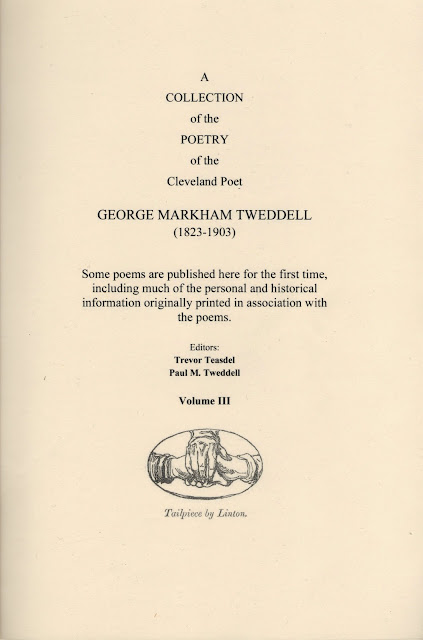
In 2009 Paul Tweddell showed me (Trev Teasdel) some handwritten notebooks of GMT’s poems, compiled towards the end of his life which indicated to us that he might have been trying to bring together the many poems he’d had published and some unpublished poems together for publication under different themes eg Sonnets of Flowers and Trees. Some of the critics, but not all by any means, had been less than kind to him. Looking at the range of poems and the number of poems Paul and I had collected, we realised that GMT was indeed not only a prolific poet but there was a wide range of styles, subject areas and a powerhouse hitherto unrealised. We decided to publish them on the internet and make them available for to read, enjoy and hopefully study. The topics range for local history to world politics and everything in between. For a fuller guide to GMT’s poetry view the introduction I’ve written to them here also on this site http://georgemarkhamtweddell.blogspot.co.uk/2011/04/poets-view-of-george-markham-tweddell.html
or otherwise download the introduction on the pdf file below.
I wrote the introduction as a guide because Paul Tweddell was keen to see an academic reappraisal of GMT’s work and the guide would give some valuable starting points for any such work.
After publishing the first two volumes (available in one PDF on here) Sarah Smith (another descendant of GMT) found a further collection of poems and sent them to Paul. These are now in a second pdf file on here.
There is the possibility of more work that may be lost but so far only one more poem has come to light – the poem about the Dunmow Flitch of Bacon Custom which appears on another post on here. Copies of the first two hard copy volumes are also in various Tees Valley reference libraries.
Slowly I’m making individual collections available on separate blogspots to reflect special collections of one main theme. So far Sonnets of Flowers and Trees – with illustrations is viewable separately here http://tweddellsonnet.blogspot.co.uk/ and the 100 masonic Poems will be next ( a link will be placed here when the site is finished). I plan to do one around themes related to the many poems about Cleveland and others at some stage. meanwhile all the poems we have are available and downloadable in there collections here.
PDF 1 (you can expand this file and read on line or download it free via Google Drive.
INTRODUCTION TO THE POEMS OF GEORGE MARKHAM TWEDDELL BY TREV TEASDEL AND A BIO OF GMT BY PAUL TWEDDELL.
When it opens – click the black arrow screen left to download to your computer.or for some – Click File and then click download in the menu and the tick Save.
PDF file 2 – Acknowledgements and index to the first two volumes.
When it opens – click the black arrow screen left to download to your computer.or for some – Click File and then click download in the menu and the tick Save.
PDF file 3 – Volume 1 and 2 of the collected Poems of George Markham Tweddell
When it opens – click the black arrow screen left to download to your computer.or for some – Click File and then click download in the menu and the tick Save.
PDF file 4 – Volume Three of George Markham Tweddell (kindly supplied by Sarah Smith)
When it opens – click the black arrow screen left to download to your computer.or for some – Click File and then click download in the menu and the tick Save.
In addition to these collected poems, I discovered another full poem not included and a couple of small commentary poems by Tweddell under his Peter Proletarius name in his book Shakespeare, His Time and Contemporaries.
First the short poems from the Shakespeare book – the first being a short piece to introduce the book –
“Since most that is known of the personal history of Shakespere is but trifling, let us carefully study the history of the period in which he lived.” Peter Proletarius. 1862
“Know this, ye demons in the shape of men!
To torture those whom you can not convince
That our own dogmas can only be true
Is never pleasing in the sight of God ;
Whose essence being from pollution free,
delights not in the woes of human kind,
Like those who to themselves do arogate
The keeping of the oracles of God.”
Peter Proletarius.
“Fortune her fickle blessings sometimes sheds
Upon a zany’s head. ‘Tis kindly done,
And saveth many men from feeling pains
their worthier bretheren oftimes must endure.”
Peter Proletarius.
And this on is in another post on this blog – and from the John Andrews book on the Flitch of Bacon
Rhymes and Sketches to Illustrate the Cleveland Dialect – Florence Cleveland (Elizabeth Tweddell) 1875
Rhymes and Sketches to Illustrate the Cleveland Dialect – Florence Cleveland.
View or download the pdf of the book free on this page (see below).
Elizabeth Tweddell aka Florence Cleveland (wife of George Markham Tweddell) was a popular poet and writer in her own right. Her book Rhymes and Sketches to Illustrate the Cleveland Dialect first published in 1875 was reprinted in 1892 and again 1903. The book and the poems is still of interest to readers today and recently the popular Stockton folk duo Megson, named their first album after one her poems in this book – Take Thyself A Wife and set the poem to music as a contemporary folk song.
Both Elizabeth and George were keen on preserving the Cleveland dialect through verse and prose at a time when the dialect was beginning to die out. Elizabeth, like George, had many non dialect poems and stories published in magazines and newspapers in the UK, Australia, Europe and the USA. We have collected together many of George’s and published them here on this site, via note books found by the Tweddell family .We don’t have any notebooks for Elizabeth but poems that have been found are posted on this site in the page above entitled Florence Cleveland where you will also find more information on Elizabeth Tweddell.
You can read more of Florence Cleveland on this page – also on this site – along with photos and other information http://georgemarkhamtweddell.blogspot.co.uk/p/florence-cleveland.html
Here is Megson singing Take Thy Self a Wife (the original dialect version is in this book)
Tweddell in Horsfall Turner’s Yorkshire Bibliographer 1890
The following PDF article, from the Tweddell family collection, is an interview with George Markham Tweddell and his wife – Elizabeth Tweddell aka Florence Cleveland by S. Horsfall Turner in 1890, editor of the book Yorkshire Genealogist with which is Incorporated Yorkshire Bibliographer Volume 11 – published in Bradford. The full book is also now available to read on line here http://archive.org/stream/yorkshirenotesa00turngoog#page/n8/mode/1up
The full history of the Tweddell’s can be read here on the Tweddell History site http://www.tweddellhistory.co.uk/index.html


George Markham Tweddell would have been about 66 when the interview was conducted in 1889, having been born in 1823. The Tweddell’s were living at Rose Cottage (The Town House) in Bridge Street Stokesley and the interview provided a lot of useful background information on the couple and their work.
Horsfall gives a good account of George’s early life and education, through to his employment as an apprentice printers, editor, poet, Oddfellow and author. Along the way he includes some great good wood cuts of the Cleveland area, poems by both George and his wife Elizabeth and his connections with literary friends such as Ebenezer Elliot.
When it opens – click the black arrow screen left to download to your computer.or for some – Click File and then click download in the menu and the tick Save.
Here are the woodcuts that are in the article but the right way up!
Rudby School, Hutton Rudby. John Jackson, William Sanderson
Paul Tweddell, as a former School Inspector and educationalist, was particularly interested in his ancestor – George Markham Tweddell’s ideas on education back in the 19thC. GMT’s ideas are scattered throughout his work and he placed great hope for mankind and civilisation through the development of wider education and communications. He may well have been disappointed given the recent investigation into the practice of the modern media and the disarray of the education system but this poem GMT’s views on education wouldn’t be out of place in Paulo Freire’s book Pedagogy of the Oppressed (1972) where Freire talks about the ‘Banking Concept of education’ in which the student receives, memorises and repeats ‘deposits of knowledge’ rather than develops a ‘critical consciousness and spirit of enquiry’.
Education.
To educate does not mean pumping in
Knowledge, even to cramming in the brain;
But, by judicious efforts, so to train
The virgin mind, that it must surely win
Wisdom from all it reads or hears or sees; 5
So that it may educe by its own powers
True thoughts and actions: for such gifts are ours,
If we but knew their use. Like industrious bees,
We can cull honey from the plants poisonous
To others. God has freely given to all 10
The power of thinking, and erects no wall
To fence this blessing from us, which to us
Should be the highest prized of all things given
To us on earth to wing our souls for heaven.
George Markham Tweddell
[Rhymes in M/S, notional p. 66]
GMT’s Own Education – William Sanderson
Paul Tweddell writes in the first draft of his forthcoming genealogical study of the Tweddell family “Poor lives, but full of honour“
” At the time George reached the age of 11 in 1834, an endowed grammar school was set up in Stokesley. Preston school, named after the person who had granted the original bequest in 1805. But rather than enthusiastically offering a place to a child of obvious intellectual ability, the school authorities turned George’s application down. The reason can now only be speculation, but could it be that the conservative governors noted the fierce independence he was to shown later life!…
Instead of the academic curriculum of the grammar school, George was given a functional education offered at the local National school. By good fortune he came in contact with an Inspirational teacher, William Sanderson (c.1796-1864) who held the post of head teacher at the National Board School. Like George’s informal education from his mother given in fields around the town, Sanderson expanded the school’s teaching by taking the boy on long walks in the countryside during fine evenings or at his fire in winter. During their discussions the boy’s knowledge of science, philosophy and history was built up and he was given a life-long love of literature. particularly for poetry. It is likely that his future radical views were also developed at the school.
In the 1820s, Sanderson had left his native Hutton Rudby (three miles west of Stokesley) to set up a private school in Whitby. During the 1832 Reform Parliament election he had voted for the radical, but unsuccessful candidate (Sanderson’s choice inevitably being widely known, there being no secret ballot at this time) and, in revenge, another failed candidate persuaded the parents to withdraw their children thus forcing the closure of the school. Taking up the Stokesley vacancy, Sanderson soon recognised George’s abilities. Sanderson’s account of his treatment in Whitby was an powerful influence on his student’s adoption of radical-leaning politics, although the boy may have already had a predilection in this way as his grandfather, John Tweddell (1770-1850), had supported the Liberal candidate in the 1805 election. A few years later, hearing Peter Bussey, the Chartist missionary who used Stokesley as a base for his work in spring 1839 when George was 17, could have reinforced these opinions, although there is no documentary evidence for this.
In 1836, at the earliest opportunity and much to his disappointment, George was taken away from school and joined his mother as an assistant at his grandfather’s shop and by 1841 William Braithwaite (c.1810-1873)”
In 2009, Paul Tweddell showed me where William sanderson was buried – at All Saints Church on the Rudby side of Hutton Rudby nr Stokesley North Yorkshire.
Thanks to local Hutton Rudby historian Alice Barrigan we now know that Rudby School was situated near All Saints on the left in this photo from Alice Barrigan’s website http://northyorkshirehistory.blogspot.co.uk/
Here is a poem which GMT wrote as a tribute to William Sanderson
Education
A Tribute to the Memory of my good Schoolmaster—
William Sanderson.
I do not know one holier work on earth
Than that of training up the rising race
In health alike of body and of mind.
It is the safest polity for States;
The truest proof of love parents can give, 5
The noblest outcome of philanthropy;
And without it Religion would become
But Superstition to bind all in chains
To every sort of hateful tyranny.
Some six-score years have now pass’d o’er the world 10
Since a true poet sang in noble strains:—
“Delightful task! to rear the tender thought,
To teach the young idea how to shoot,
To pour the fresh instruction o’er the mind,
To breathe the enlivening spirit, and to fix 15
The generous purpose in the glowing breast!”[1]
A noble thought, utter’d in words of fire
Which Ignorance can ne’er extinguish, though
We yet have feeble intellect which fain
For this would ridicule dear Thomson’s name. 20
The car of Progress has run swiftly on
Since so he sang, and his melodious lyre
Silenced on earth, but its sweet echoes still
Stir human hearts, though we are only now
Just rising to the level of his thoughts: 25
For your true Poet is not one who can
Merely bedeck in decent verse what all
His fellows feel or know: but it is his
To lead the van in bravely marching on
From height to height, despite all earthly foes; 30
And those who ridicule the Teacher’s art,
Or look on it as drudgery, have ne’er,
Whate’er their bookcram, gain’d the mental light
Required of all true Teachers: unto them
’T would be indeed as hard a task as that 35
Which Jupiter enjoin’d on Sisyphus.
I had three Schoolmasters: but the former two ne’er gain’d
The least affection from the boys they sought
To teach in their own harsh mistaken way,
And to us all their deaths had been relief, 40
Instead of causing one to shed a tear.
In looking back upon the years I spent
Under their tyranny, which I forgive,
But never can forget, I cannot yield
Those days with that bright halo that endears 45
Our boyhood to us in declining years.[2]
But I shall treasure, to my dying day,
The love I bore to William Sanderson.
He was my last Schoolmaster, and my best,
Yea worth a thousand of the other two,[3]— 50
For he unlike to them, knew how to teach.
He had all learning at his fingers’ ends;
And best of all, was skill’d in teaching too.
A man may be in scholarship most rife,
Yet quite unfit to teach a tithe he knows. 55
Oh! that I longer could have profited
By my good Mentor! More that fifty years
Of varied trials I have waded through,
Since the necessity of earning bread
Forced me to leave him, when my anxious mind 60
Was just beginning to show healthy growth
Under his culture. But I never ceased
To love him whilst he lived, and since his death
None could have treasured more his memory.
“God rest his soul!” I can devoutly say; 65
For he was fitted whilst on earth for heaven:
Not by a bigot’s creed, or cant too oft
Mistaken for true piety; but a life
Of Christian virtue. Too mild to wrestle
In competition for a living here 70
With brutal men, his purse through life was poor;
But he had riches they can ne’er possess
Euclid, Algebra, and the languages,
Hebrew, Greek, Latin, like our mother-tongue,
Were truly his. Had I remain’d with him 75
I too would have been a scholar deeply read
In lore which has been seal’d to me for aye.
How he delighted to encourage all
My boyish studies of antiquity
And of the maxims which should govern States 80
To make the peoples happy! Meekest man
I ever knew childlike simplicity
Wedded to wisdom gave the lie in him
To those who fancy knowledge puffeth up
With vile conceit those who have made it theirs. 85
Oh, much I owe to him, to be repaid
Only with gratitude! My evening hours
Were spent in his congenial company
After the studies of the school were done.
If fine, we wander’d forth in frost or sheen 90
Along the pleasant footpaths; if confined
By weather to his parlour, he to me
Read Greek and Latin Classics, Englishing
Each sentence as he read, as easily
As I could converse in my mother-tongue. 95
This was my baptism to communion
With the wise sages both of Greece and Rome,
Homer and Virgil both have seem’d to me
As friends I knew since then; Demosthenes
And Cicero through him spoke just to me 100
As plainly as to those who had of yore
Listen’d unto their marvellous eloquence,
And this most mild of men was stricken down
When he was rising in prosperity;
Robb’d of his bread, and exiled the town 105
Where he was teaching as few other could,
By Whitby Tories, because he quietly
Voted for Moorsholm when that post became
A parliamentary borough. Not the man
To canvass or make speeches, or i’ the press 110
To rouse the people with a Cobbett’s pen,
Or hate those who might not think like himself,
Yet he felt bound to be to conscience true,
And simply gave his vote. It was enough—
The ballot then affording such no shield, 115
But being call’d un-English, cowardly,
And something that must lead to ruin, by
The cravens who all used it in their clubs.
Methinks I see their shuddering souls when they
First met him in that Spirit Land where all 120
Our sins on earth are plainly seen as though
An open book contain’d the register.
’T is this, and such as this, which forms the Hell
Which blundering bigots would persuade mankind
Is sulphurous fire which ever burns 125
To torture with far greater pains than man
Or woman ever felt on earth—pangs which
When millions of years had o’er them pass’d
Would be no nearer to their end than when
They first began—God’s thoughtless erring ones. 130
And there are simple folks still hold this creed,
Most gloomy and blasphemous as it is,
Making our Heavenly Father more unkind
To his poor children than the basest man
Who ever practised horrid cruelties. 135
One master as to mine, teaching true wisdom
Calmly all his years; living its precepts;
Content with simplest necessities when
He could obtain them; but aspiring not
Even when forced to bear ills none should know 140
In any State call’d civilised; does more
For helping on the progress of our race
Than many brawlers; and I thank my God
That I in early life had such a friend
And teacher as good William Sanderson. 145
His life was one of spotless purity:
He had compassion for all living things,
And anger never raged in his calm mind.
In all my march through life, I never met
A man more Christlike, no forms or creeds 150
Held his as a professor before men,
And he never mix’d in their assemblies.
He made his heart the temple of the Lord,
And there he offer’d up incense more sweet
Than from a priestly censor rose. 155
Though in the flesh we never more can meet,
His spirit often seems to visit me
In a divine communion of soul;
And I look forward with a fervent faith
To meeting him again to part no more, 160
Where all our souls are purified like him
From those deep failings which prevent our earth
From being but a counterpart of heaven.
Blank verse [in M/S], pp. 71-79.
[1] From the Scottish poet, James Thompson (1700-1748), in ‘Spring’ from ‘The
Seasons’ (1726). “Six-score years” this would make the date of GMT’s poem
about 1846. [see:
<www.luminarium.org/eightlit/thomson/bio.php>
[2] Alternative to this line:
“Our boyhood to us as death dreweth near”[3] One of these will have been Richard
Baker, mentioned in Pigot’s Yorkshire Directory for 1829.
…………………………………………………………
 Before William Sanderson, Rudby school was headed by John Jackson of whom GMT also wrote in his Yorkshire Miscellany and North of England Tractates and yet again in his book The Bards and Authors of Cleveland and south Yorkshire 1872.
Before William Sanderson, Rudby school was headed by John Jackson of whom GMT also wrote in his Yorkshire Miscellany and North of England Tractates and yet again in his book The Bards and Authors of Cleveland and south Yorkshire 1872.
Tweddell wrote –
“ John Jackson, who for six and twenty years ws master of Rudby School, was so much esteemed as a classical and mathematical teacher that sons of the principal inhabitants of Stokesley used to travel daily to and from his academy to avail themselves of his instruction. Many of the sundials still existing in Cleveland are of his manufacture, that at Rudby church being one. He was born about the year 1743 and died May 27th 1808, in the sixty fifth year of his age, leaving a widow named Ann, who survived him until dec 27th 1815, when she died at the age of 67.
 John Jackson wrote the following poem The Cleveland Fox Chase, in 1785 although it wasn’t published until 1846 by George Markham Tweddell in his Yorkshire Miscellany series and later the North of England Tractates. The 63 mile fox chase which went past the famed Roseberry Topping near Great Ayton, may not agree with our modern sensibilities towards fox hunting but this historic poem by the master of Rudby school was also set to music by him “and for many years enjoyed considerable popularity in the district, on account of the ‘then well known incidents of the remarkable hunt it chronicles” says Tweddell in 1846. The version from the Tractates is in the pdf file here. Further information on the Cleveland foxhunt can be found in Roseberry Topping p66 published by the Great Ayton Community Archeology Project
John Jackson wrote the following poem The Cleveland Fox Chase, in 1785 although it wasn’t published until 1846 by George Markham Tweddell in his Yorkshire Miscellany series and later the North of England Tractates. The 63 mile fox chase which went past the famed Roseberry Topping near Great Ayton, may not agree with our modern sensibilities towards fox hunting but this historic poem by the master of Rudby school was also set to music by him “and for many years enjoyed considerable popularity in the district, on account of the ‘then well known incidents of the remarkable hunt it chronicles” says Tweddell in 1846. The version from the Tractates is in the pdf file here. Further information on the Cleveland foxhunt can be found in Roseberry Topping p66 published by the Great Ayton Community Archeology Project
John Jackson – The Cleveland Fox Chase – published in 1846 in Tweddell’s Yorkshire Miscellany and later Tweddell’s North of England Tractates (from which this pdf contains). The pdf is on Google drive and can be downloaded.
When it opens – click the black arrow screen left to download to your computer.or for some – Click File and then click download in the menu and the tick Save.
Tweddell’s North of England Illustrated Annual – Extracts
This PDF file (downloadable via Google Drive) contain extract pages from Tweddell’s North of England Illustrated Annual – 1879 -80
These extracts contain poems by the following –
- Mrs G. Tweddell – aka Elizabeth Tweddell or Florence Cleveland– In Memorium / Saint Hilda’s Bells (A Whitby Legend)/ Introduction to a Christmas Pantomimeof “Robinson Crusoe”
- Jabez Cole – Sonnet Written in Ingleby-Greenhow Church Yard / The Marble Monument.
- T.P. Williamson – “Suffered Under Pontius Pilate” /
- Henry Wade – Come Where Sing The Little Rills.
- William Henry Charlton – Old English Romance of Havelok the Dane (extract) and full poem NOW” AND “OF OLD”
- John Reed Appleton FSA by Peter Proletarius (One of Tweddell’s pen names) (an extract).
- North of England Notes – George Markham Tweddell – the essay discusses the
- History of the Dunmow Flitch of Bacon Custom by Mr Williams Andrews of Hull FRHS (more on this custom below) /
- A Portrait of the late Matthew Greathead, the Centenarian Freemason from High Coniscliffe on the banks of the Tees Nr Darlington. /
- Patent Safety Detaching Hook invented by Mr William Walker, mining engineer of Saltburn by the Sea. / North Yorkshire Miners Association.
- History of the Craft of Freemasonry in Cumberland and Westmoreland by bro. WF Lamonby PM, P. Prov. G. Reg. /
- American Newspapers and English Journals /
- Literary Reminiscences and Gleanings Mr Proctor /
- History of the Darlington and Barnard Castle Railway – Mr Atkinson of the Teesdale Mercury.
- White Star Line of Steamers – Official Guide /
- The Tragedy of Antigona – Theatre Royal, Newcastle / ……………
- Inscription on “The Wainstones,” Broughton Bank – Peter Proletarius (ie Tweddell)
- Old Gregory’s Ghost – Or How Mr Playfair spent Christmas Eve at Buffing Hall – Oliver Louis Tweddell (Extract)
- Title pages to The Story of Count Ulaski – Miss Elizabeth Colling aka Eta Mawr of Hurworth on Tees
When it opens – click the black arrow screen left to download to your computer. or for some – Click File and then click download in the menu and the tick Save.
More information on some of the material –
THE HISTORY OF THE DUNMOW FLITCH TRIALS
 By the 14th century, the Dunmow Flitch Trials had achieved far-reaching notoriety. The author William Langland, who lived on the Welsh borders, mentions it in his 1362 book ‘The Vision of Piers Plowman‘ in a manner that implies general knowledge of the custom among his readers.” Read More here http://www.dunmowflitchtrials.co.uk/history/
By the 14th century, the Dunmow Flitch Trials had achieved far-reaching notoriety. The author William Langland, who lived on the Welsh borders, mentions it in his 1362 book ‘The Vision of Piers Plowman‘ in a manner that implies general knowledge of the custom among his readers.” Read More here http://www.dunmowflitchtrials.co.uk/history/ |
| Elizabeth Tweddell’s poem |
 |
| Little Dunmow – Priory Lodge |
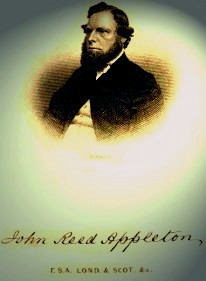 |
| From Tweddell’s Bards and Authors of Cleveland and South Durham 1872 |
Stokesley News and Cleveland Reporter
Asa Briggs – “There was no gloomier year in the nineteenth century than 1842″ “Yet in November of that year George Markham Tweddell burst into print with his monthly newspaper The Stokesley News and Cleveland Reporter priced 2d.” Writes Stokesley local historian Daphne Franks in her brilliant pamphlet Printing and Publishing in Stokesley – published 1984.
Here are some mast heads and pieces from George Markham Tweddell’s radical Stokesley based newspaper about 1842 as supplied by Paul Tweddell from his Tweddell archives..the Stokesley News and Cleveland Reporter. The story of his newspaper and the rival newspaper can be found here http://www.tweddellhistory.co.uk/chapter3.html. .
 Basically – George Markham Tweddell was apprenticed to Stokesley printer William Braithwaite at 30, The High Street (now a paper shop). Braithwaite had the reputation of supporting promising young employees and George met and became friends with John Walker Ord author of The History and Antiquities of Cleveland (1838) which was printed by William Briathwaite.
Basically – George Markham Tweddell was apprenticed to Stokesley printer William Braithwaite at 30, The High Street (now a paper shop). Braithwaite had the reputation of supporting promising young employees and George met and became friends with John Walker Ord author of The History and Antiquities of Cleveland (1838) which was printed by William Briathwaite.
“In 1841 when 18 George sought approval from his master to set up a newspaper and his master agreed, in spite of the obviously radical tone George proposed (‘to give the ordinary people of Cleveland a newspaper that would reflect their more liberal opinions rather than those of the landowning classes‘). The first copy of the Cleveland News and Stokesley Reporter appeared on the 1st of November 1842 being printed on Braithwaite’s presses. The newspaper supported causes such as the Anti-Cornlaw league, the abolition of slavery etc.
 Unfortunately, by the time a third edition of his newspaper was being planned, representatives of the local propertied class visited Braithwaite to persuade him to stop broadcasting George’s criticism of the Tory government, of which they were firm supporters. They demanded Braithwaite withdrew the use of his printing press and the licence to publish from the premises. As a result the printer dismissed George (probably on the legal grounds of “bringing his master into disrepute”). Within a month, remarkably, George had managed to acquire a new license and access to a new press (although from whom is not known) to produce the third edition on time. For George, the contents for the editorial for this edition were obvious and he castigated his former employer, claiming Braithwaite was trying to ‘crush our little periodical’, and that ‘our printer is a good easy man, afraid that our generous principles of peace on earth and goodwill toward men should be mistaken for his own’. ” Paul Tweddell http://www.tweddellhistory.co.uk/chapter3.html
Unfortunately, by the time a third edition of his newspaper was being planned, representatives of the local propertied class visited Braithwaite to persuade him to stop broadcasting George’s criticism of the Tory government, of which they were firm supporters. They demanded Braithwaite withdrew the use of his printing press and the licence to publish from the premises. As a result the printer dismissed George (probably on the legal grounds of “bringing his master into disrepute”). Within a month, remarkably, George had managed to acquire a new license and access to a new press (although from whom is not known) to produce the third edition on time. For George, the contents for the editorial for this edition were obvious and he castigated his former employer, claiming Braithwaite was trying to ‘crush our little periodical’, and that ‘our printer is a good easy man, afraid that our generous principles of peace on earth and goodwill toward men should be mistaken for his own’. ” Paul Tweddell http://www.tweddellhistory.co.uk/chapter3.html“When The Stokesley News, and Cleveland Reporter first made its appearance in the political and literary world, it was with a firm determination to lash every species of vice, with an unsparing hand; and to be the unflinching advocate of civil and religious liberty. Fearlessly to tear the mask from the sinister deeds of unprincipled legislators and trafficking politicians, of every party……”
.jpg)
 On the brighter side, reports of entertainment on a grand scale, seen in Stokesley on Saturday June 17th 1843, when Van Amburgh, the distinguished American Lion Tamer, visited town with his lions, tigers and leopards. “He arrived from Northallerton at eleven O’Clock, driving a team of eight beautiful cream horses, accompanied by his own band and followed by vehicles containing the animals. A splendid marquee was erected in Mrs Wilstrop’s paddock, now the site of the Stokesley Health Centre and performances given to densley crowded audiences“. It was noted that the animals were very well kept. Stokesley people were not the only admirers of Van Amburgh; it seems that “the young Queen Victoria particularly enjoyed circuses and was delighted to discover that the Drury Lane pantomime of 1838 included Van Amburgh’s lions. Despite an awful squint of the eye Van Amburgh grappled with the animals, threw them to the ground while they angrily roared and then lay upon them.” “It’s quite beautiful to see and makes me wish I could do the same.” was the wistful and mind boggling comment. She returned repeatedly, seven times in six weeks to see the lions”
On the brighter side, reports of entertainment on a grand scale, seen in Stokesley on Saturday June 17th 1843, when Van Amburgh, the distinguished American Lion Tamer, visited town with his lions, tigers and leopards. “He arrived from Northallerton at eleven O’Clock, driving a team of eight beautiful cream horses, accompanied by his own band and followed by vehicles containing the animals. A splendid marquee was erected in Mrs Wilstrop’s paddock, now the site of the Stokesley Health Centre and performances given to densley crowded audiences“. It was noted that the animals were very well kept. Stokesley people were not the only admirers of Van Amburgh; it seems that “the young Queen Victoria particularly enjoyed circuses and was delighted to discover that the Drury Lane pantomime of 1838 included Van Amburgh’s lions. Despite an awful squint of the eye Van Amburgh grappled with the animals, threw them to the ground while they angrily roared and then lay upon them.” “It’s quite beautiful to see and makes me wish I could do the same.” was the wistful and mind boggling comment. She returned repeatedly, seven times in six weeks to see the lions” “Isaac A. Van Amburgh (1811–1865) was an American animal trainer who developed the first trained wild animal act in modern times. By introducing jungle acts into the circus, Van Amburgh paved the way for combining menageries with circuses. After that, menageries began using equestrian and clown performances in circus rings. Gradually the distinction between circus and menagerie faded. He was the first act to put his head in a lion’s mouth”
A Poet’s view of George Markham Tweddell (1823-1903)
- Lost co-editor Paul Tweddell, whose work was invaluable
- Confirmed the connection between Tweddell and Ebenezer Elliot and there is now a page on that on the Ebenezer Elliot site http://www.judandk.force9.co.uk/Tweddell.html
- Confirmed Tweddell’s awareness of the work of Whitby Chartist / author john Watkins via Whitby Authors and their publications – Gideon Smales 1867.
- Discovered, in the Tweddell family, another volume of Tweddell’s poems, many never published and soon to be made available.
- Paul Tweddell’s well researched Tweddell Family History – Poor Lives but with Honour, is soon to be published.
- A major update to the Tweddell History website with Paul’s additional research is due soon.
More fruitful was a link Paul made with Montgomery, finding a poem that may have influenced GMT’s poem in the Stokesley News and Cleveland Reporter. (Ebenezer Elliott knew James Montgomery who lived mostly in Wakefield.). Compare Montgomery’s poem with GMT’s later poem below:
A Cry from South Africa
On building a chapel at Cape Town
For negro slaves of the colony, in 1828
Britain not now I ask of thee
Freedom, the right of bond and free;
Let Mammon hold, while Mammon can,
The bones and blood of living man;
Let tyrants scorn, the tyrants dare,
The shrieks and writings of despair
An end will come – it will not wait
Bonds, yokes, and scourges have their date,
Slavery itself must pass away,
And be a tale of yesterday.
James Montgomery (1771-1854)
ix
An African Slave
Ye tyrant fiends! who dare usurp
Power o’er your fellow man.
You fill all earth with misery,
The grave you never can.
There ‘tis your pow’r stops short,
You can no further go:
The tomb’s the last, but sure, retreat
From tyranny and woe.
Even kings must rot like common men,
And will return to clay;
And, cheek by jowl, tyrant and slave
Will by each other lay.
‘Georgius’
[One of GMT’s nom de plumes, see p. 6 below]
JOHN CRITCHLEY PRINCE
John Critchley Prince, (mentioned further in the next section) could also have been a strong influence on GMT, for they shared similar radical opinions. For a while in the early 1840s Prince worked on a newspaper, The Herald of the Future, that espoused Corn Law repeal and the 1833 10 hour Factory Act. He also worked with the Manchester Odd Fellows in Blackburn. Tweddell and Prince corresponded from 1842 firstly concerning the publication of some of Prince’s poems in GMT’s newspaper (Stokesley News and Yorkshire Miscellany). It continued through their shared circumstances and increasingly warm friendship until 1851 when Prince wrote to GMT, “Your fortunes and mine are very much alike,” referring particularly to their shared poverty. They met up finally in 1855 when the Tweddells moved to Bury. Compare the styles:
The Primrose (Primula vulgaris).
